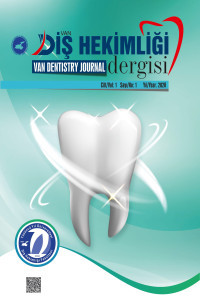Multiple Flebolitlerle Birlikte Görülen Hemanjiyomlar: Vaka Serisi
Flebolit, hemanjiyom, panoramik radyografi
Hemangiomas Associated With Multiple Phlebolites: Case Series
Phlebolite, hemangioma, panoramic radiography,
___
- 1. Adams DM, Lucky AW. Cervicofacial vascular anomalies. I. Hemangiomas and other benign vascular tumors. Semin Pediatr Surg. 2006;15(2):124-32
- 2. Mohan RPS, Dhillon M, Gill N. Intraoral venous malformation with phleboliths. Saudi Dent J. 2011;23(3):161-3.
- 3. Mandel L, Surattanont F. Clinical and imaging diagnoses of intramuscular hemangiomas: the wattle sign and case reports. J Oral Maxillofac Surg. 2004;62(6):754-8.
- 4. Altuğ HA, Büyüksoy V, Okçu KM, Doğan N. Hemangiomas of the head and neck with phleboliths: clinical features, diagnostic imaging, and treatment of 3 cases. Oral Surg Oral Med Oral Pathol Oral Radiol Endod. 2007;103(3):60-4.
- 5. Sivrikaya EC, Cezairli B, Ayranci F, Omezli MM, Erzurumlu ZU. Buccal vascular malformation with multiple giant phleboliths: a rare case presentation and review of the literature. Oral Maxillofac Surg. 2019;23(3):375-80.
- 6. Gouvêa Lima GDM, Moraes RM, Cavalcante ASR, Carvalho YR, Anbinder AL. An isolated phlebolith on the lip: an unusual case and review of the literature. Case Rep Pathol. 2015;2015.
- 7. Parker Jr LA, Frommer HH. Phleboliths: Report of a case. Oral Surg. Oral Med. Oral Pathol. 1964;18(4):476-80.
- 8. Freire V, Moser TP, Lepage-Saucier M. Radiological identification and analysis of soft tissue musculoskeletal calcifications. Insights imaging. 2018;9(4):477-92.
- 9. Hassani A, Saadat S, Moshiri R, Shahmirzadi S. Hemangioma of the buccal fat pad. Contemp Clin Dent. 2014;5(2):243.
- 10. Zachariades N, Rallis G, Papademetriou J, Konsolaki E, Markaki S, Mezitis M. Phleboliths. A report of three unusual cases. Br J Oral Maxillofac Surg. 1991;29(2):117-9.
- 11. Kato H, Ota Y, Sasaki M, Arai T, Sekido Y, Tsukinoki K. A phlebolith in the anterior portion of the masseter muscle. Tokai J Exp Clin Med. 2012;37(1):25-9.
- 12. Moreira‐Souza L, Michels M, Lagos de Melo LP, Oliveira ML, Asprino L, Freitas DQ. Brightness and contrast adjustments influence the radiographic detection of soft tissue calcification. Oral Dis. 2019;25(7):1809-14.
- 13. Lee JK, Lim SC. Intramuscular hemangiomas of the mylohyoid and sternocleidomastoid muscle. Auris Nasus Larynx. 2005;32(3):323-7.
- 14. Meyer JS, Hoffer F, Barnes P, Mulliken J. Biological classification of soft-tissue vascular anomalies: MR correlation. AJR Am J Roentgenol. 1991;157(3):559-64.
- 15. Scolozzi P, Laurent F, Lombardi T, Richter M. Intraoral venous malformation presenting with multiple phleboliths. J Oral Surg Oral Med Oral Pathol Oral Radiol Endod. 2003;96(2):197-200.
- 16. Bar T, Zagury A, London D, Shacham R, Nahlieli O. Calcifications simulating sialolithiasis of the major salivary glands. Dentomaxillofac Radiol. 2007;36(1):59-62.
- 17. Carter LC. Soft tissue calcifications and ossifications. Oral Radiology: Elsevier; 2014. p. 524-41.
- 18. Keberle M, Robinson S. Physiologic and pathologic calcifications and ossifications in the face and neck. Eur Radiol. 2007;17(8):2103-11.
- 19. Dempsey E, Murley R. Vascular malformations simulating salivary disease. Br J Plast Surg. 1970; 23:77-84.
- 20. O'riordan B. Phleboliths and salivary calculi. Br J Oral Surg. 1974;12(2):119-31.
- 21. Su Yx, Liao Gq, Wang L, Liang Yj, Chu M, Zheng Gs. Sialoliths or phleboliths? Laryngoscope. 2009;119(7):1344-7.
- 22. Katz JO, Langlais RP, Underhill TE, Kimura K. Localization of paraoral soft tissue calcifications: the known object rule. Oral Surg Oral Med Oral Pathol. 1989;67(4):459-63.
- 23. Carter LC. Discrimination between calcified triticeous cartilage and calcified carotid atheroma on panoramic radiography. Oral Surg Oral Med Oral Pathol Oral Radiol Endod. 2000;90(1):108-10.
- 24. Scarfe W, Farman A. Soft tissue calcifications in the neck: Maxillofacial CBCT presentation and significance. AADMRT Currents. 2010;2(2):3-15.
- 25. Balaji Babu B, Avinash Tejasvi M, CK AA, Chittaranjan B. Tonsillolith: a panoramic radiograph presentation. J Clin Diagn Res. 2013;7(10):2378.
- 26. Capote TS, Almeida Gonçalves MD, Gonçalves A, Gonçalves M. Panoramic radiography—diagnosis of relevant structures that might compromise oral and general health of the patient. Emerging Trends in Oral Health Sciences and Dentistry. 2015. p. 748
- 27. Peter T, Cherian D, Peter T. Calcifications in Neck Region: an Insight. Cukurova Medical Journal 2015;40(2):326-329.
- Başlangıç: 2020
- Yayıncı: Van Yüzüncü Yıl Üniversitesi
Hüseyin GÜNDÜZ, Muhammed Reşit ARVAS, Caner ÜNEL
Bebek Hastada Fibro-Epitelyal Hiperplazi Nadir Bir Olgu Sunumu
Murat TUNCA, Yasemin TUNCA, Seda KOTAN, Selma BİLEN
Kanıta Dayalı Ortodonti: İnançlar ve Gerçekler
Nihal FAHRZADEH, Yasemin TUNCA, Seda KOTAN, Murat TUNCA
Diş Hekimlerinin COVID-19 Pandemisi ve Aşısına Karşı Tutumlarının Değerlendirilmesi
Geniş Periapikal Lezyonlu Dişlerin Cerrahi Olmayan Kök Kanal Tedavisi: Olgu Serisi
Babak MOBARAKI, Solmaz MOBARAKİ
Multiple Flebolitlerle Birlikte Görülen Hemanjiyomlar: Vaka Serisi
Gülçin SARI, Özge DÖNMEZ TARAKÇI, Gökhan ÖZKAN
Gömülü Alt İkinci Molar Dişle İlişkili Dentiregöz Kistin Dekompresyon Yöntemi ile Tedavisi
Levent CİĞERİM, Volkan KAPLAN, Mehmet GÜZEL, Mohammad Abdelqader Fahmi BSAILEH
